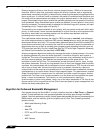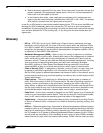
Firewall Settings > QoS Mapping
773
SonicOS 5.8.1 Administrator Guide
include at a minimum Default, Assured Forwarding, and Expedited Forwarding.
DiffServ is supported on SonicWALL NSA platforms. Refer to the “DSCP Marking” section
on page 757 for more information.
• Discarding – A congestion avoidance mechanism that is employed by QoS systems in an
attempt to predict when congestion might occur on a network, and to prevent the
congestion by dropping over-limit traffic. Discarding can also be thought of as a queue
management algorithm, since it attempts to avoid situations of full queues. Advanced
discard mechanisms will abide by CoS markings so as to avoid dropping sensitive traffic.
Common methods are:
–
Tail Drop – An indiscriminate method of dealing with a full queue wherein the last
packets into the queue are dropped, regardless of their CoS marking.
–
Random Early Detection (RED) – RED monitors the status of queues to try to
anticipate when a queue is about to become full. It then randomly discards packets in
a staggered fashion to help minimize the potential of Global Synchronization. Basic
implementations of RED, like Tail Drop, do not consider CoS markings.
–
Weighted Random Early Detection (WRED) – An implementation of RED that factors
DSCP markings into its discard decision process.
• DSCP – (Differentiate Services Code Points) – The repurposing of the ToS field of an IP
header as described by RFC2747. DSCP uses 64 Code Point values to enable DiffServ
(Differentiated Services). By marking traffic according to its class, each packet can be
treated appropriately at every hop along the network.
• Global Synchronization – A potential side effect of discarding, the congestion avoidance
method designed to deal with full queues. Global Synchronization occurs when multiple
TCP flows through a congested link are dropped at the same time (as can occur in Tail
Drop). When the native TCP slow-start mechanism commences with near simultaneity for
each of these flows, the flows will again flood the link. This leads to cyclical waves of
congestion and under-utilization.
• Guaranteed Bandwidth – A declared percentage of the total available bandwidth on an
interface which will always be granted to a certain class of traffic. Applicable to both
inbound and outbound BWM. The total Guaranteed Bandwidth across all BWM rules cannot
exceed 100% of the total available bandwidth. SonicOS Enhanced 5.0 and higher
enhances the Bandwidth Management feature to provide rate limiting functionality. You can
now create traffic policies that specify maximum rates for Layer 2, 3, or 4 network traffic.
This enables bandwidth management in cases where the primary WAN link fails over to a
secondary connection that cannot handle as much traffic. The Guaranteed Bandwidth can
also be set to 0%.
• Inbound (Ingress or IBWM) – The ability to shape the rate at which traffic enters a
particular interface. For TCP traffic, actual shaping can occur where the rate of the ingress
flow can be adjusted by delaying egress acknowledgements (ACKs) causing the sender to
slow its rate. For UDP traffic, a discard mechanism is used since UDP has no native
feedback controls.
• IntServ – Integrated Services, as defined by RFC1633. An alternative CoS system to
DiffServ, IntServ differs fundamentally from DiffServ in that it has each device request (or
reserve) its network requirements before it sends its traffic. This requires that each hop on
the network be IntServ aware, and it also requires each hop to maintain state information
for every flow. IntServ is not supported by SonicOS. The most common implementation of
IntServ is RSVP.
• Maximum Bandwidth – A declared percentage of the total available bandwidth on an
interface defining the maximum bandwidth to be allowed to a certain class of traffic.
Applicable to both inbound and outbound BWM. Used as a throttling mechanism to specify
a bandwidth rate limit. The Bandwidth Management feature is enhanced to provide rate


















